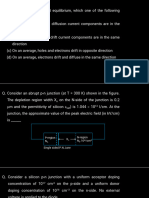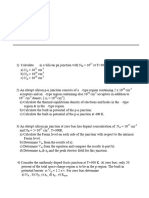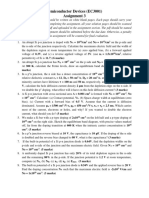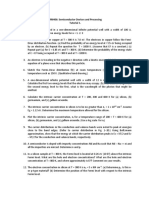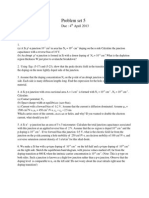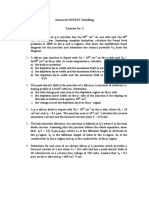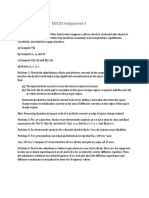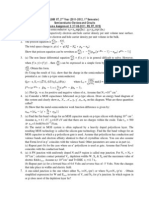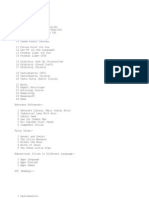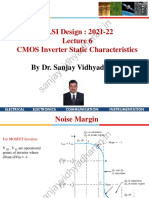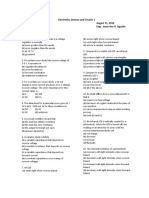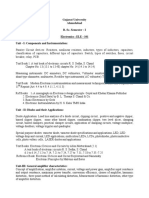Mtech Vlsi Tut
Mtech Vlsi Tut
Uploaded by
tanuj_sharma1991Copyright:
Available Formats
Mtech Vlsi Tut
Mtech Vlsi Tut
Uploaded by
tanuj_sharma1991Original Description:
Copyright
Available Formats
Share this document
Did you find this document useful?
Is this content inappropriate?
Copyright:
Available Formats
Mtech Vlsi Tut
Mtech Vlsi Tut
Uploaded by
tanuj_sharma1991Copyright:
Available Formats
Question No.
Student Roll No.
Date
1,2
21 Nov 2014
3,4
21 Nov 2014
5,6
21 Nov 2014
7,8
21 Nov 2014
9,10
21 Nov 2014
11,12
26 Nov 2014
13,14
26 Nov 2014
15,16
26 Nov 2014
17,18
26 Nov 2014
10
19,20
26 Nov 2014
11
21,22
28 Nov 2014
12
23,24
28 Nov 2014
13
25,26
28 Nov 2014
14
27,28
28 Nov 2014
15
29,30
28 Nov 2014
The seminar is to be given using PowerPoint slides only.
The solution has to be explained using the subheadings : Given Data, Parameters to be calculated,
Formulae to be used, Constants Used and Calculations.
The calculations should include each and every step.
The students in each group have to be through with all slides, they cannot pre-decide who has to
present which portion of the question.
It is the responsibility of each group to verify the solution with me well before scheduled date of
presentation.
In a particular semiconductor material, the effective density of states functions are given by Nc =
Nco (T)3/2 and Nv = Nvo(T)3/2 where Nco and Nvo are constants independent of temperature. The
experimentally determined intrinsic carrier concentrations as a function of temperature are given
in Table 1 below. Determine the product NcoNvo and the band gap energy Eg. (Assume Eg is
independent of temperature.)
Table 1 Intrinsic concentration as a function of temperature
(a) If EC - EF = 0.25 eV in gallium arsenide at T = 400 K. calculate the values of no and po.
(b) Assuming the value of no from part (a) remains constant, determine EC - EF and po, at T =
300 K.
Consider a homogeneous gallium arsenide semiconductor at T = 300 K with Nd = 1016 cm-3, Na =
0.
(a) Calculate the thermal-equilibrium values of electron and hole concentrations.
(b) For an applied E-field of 10 V/cm. calculate the drift cum density.
(c) Repeat parts (a) and (b) if Nd = 0 and Na = 1016 cm-3
(a) A silicon semiconductor is in the shape of a rectangular bar with a cross-sectional area of
100m2, a length of 0.1 cm. and is doped with 5 x 1016 cm-3 arsenic atoms. The temperature is T
= 300 K. Determine the current if 5 V is applied across the length.
(b) Repeat part (a) if the length is reduced to 0.01 cm.
(c) Calculate the average drift velocity of electrons in parts (a) and (b)
An n-type silicon sample has a resistivity of 5-cm at T = 300 K.
(a) What is the donor impurity concentration?
(b) What is the expected resistivity at (i) T = 200 K and (ii) T = 400 K.
The total current in a semiconductor is constant and is composed of electron drift current and
hole diffusion current. The electron concentration is constant and is equal to 1016 cm-3. The hole
concentration is given by
where L = 12 m. The hole diffusion coefficient is Dp = 12 cm2/s and the electron mobility is n
= 1000 cm2/V-s. The total current density is J = 4.8 A/cm2. Calculate
(a) the hole diffusion current density versus x,
10
11
12
13
14
(b) the electron current density versus x, and
(c) the electric field versus x.
An abrupt silicon p-n junction at zero bias has dopant concentrations of Na = 1017 cm-3 and
Nd = 5 x 1015 cm-3. T = 300 K.
(a) Calculate the Fermi level on each side of the junction with respect to the intrinsic Fermi
level.
(b) Sketch the equilibrium energy band diagram for the junction and determine Vbi, from the
diagram and the results of part (a).
(c) Calculate Vbi and compare the results to part b).
(d) Determine xn, xp and the peak electric field for this junction.
Consider the uniformly doped GaAs junction at T = 300 K. At zero bias, only 20 percent of the
total space charge region is to be in the p region. The built-in potential barrier is Vbi = 1.20 V. For
zero bias, determine (a) Na. (h) Nd (c) xn (d) xp and (e) Emax
Consider the impurity doping profile shown in Figure below in a silicon p-n junction. For zero
applied voltage, (a) determine Vbi (b) calculate xn and xp. (c) Sketch the thermal equilibrium
energy band diagram, and (d) plot the electric field versus distance through the junction.
A particular type of junction is an n region adjacent to an intrinsic region. This junction can he
modelled as an n-type region to a lightly doped p-type region. Assume the doping concentrations
in silicon at T = 300K are Nd = 1016 cm-3 and Na= 1012 cm-3. For zero applied bias. Determine (a)
Vbi (b) xn. (c) xp and (d) Emax . Sketch the electric field versus distance through the junction.
An abrupt silicon p-n junction has dopant concentrations of Na = 2 x 1016 cm-3 and Nd = 2 x 1015
cm-3 at T = 300 K. Calculate (a) Vbi (h) W at VR = 0 and VR= 8 V, and (c) the maximum electric
field in the space charge region at VR = 0 and VR = 8 V.
An ideal one-sided silicon n+p junction has uniform doping on both sides of the abrupt junction.
The doping relation is Nd = 50Na . The built-in potential barrier is Vbi= 0.752V. The maximum
electric field in the junction is Emax = 1.14 x 105V/cm for a reverse-bias voltage of 10 V.
T = 300 K. Determine (a) Na , Nd (b) xp for VR, = 10, and (c) Cj for VR = 10.
The built-in potential barrier of a linearly graded silicon p-n junction at T = 300 K is Vbi; = 0.70
V .The junction capacitance measured at VR = 3.5 V is C' = 7.2 x 10-9 cm-3. Find the gradient, a,
of the net impurity concentration.
Consider a p-n silicon diode at T = 300 K with doping concentrations of Na = 1018 cm-3 and Nd =
1016 cm-3. The minority carrier hole diffusion coefficient is Dp = 12 cm2/s and the minority carrier
hole lifetime is p0 = 10-7s. The cross sectional area is A = 10-4 cm2. Calculate the reverse
15
saturation current and the diode current at a forward-bias voltage of 0.50 V.
A silicon pn junction with a cross-sectional area of 10-4 cm2 has the following properties at T =
300 K:
(a) Sketch the thermal equilibrium energy-band diagram of the pn junction, including the values
of the Fermi level with respect to the intrinsic level on each side of the junction.
(b) Calculate the reverse saturation current Is? and determine the forward bias current I at a
forward-bias voltage of 0.5 V.
(c) Determine the ratio of hole current to total current at the space charge edge xn .
You might also like
- Btap Bán DẫnDocument2 pagesBtap Bán DẫnVu VoNo ratings yet
- Numericals Part 4Document19 pagesNumericals Part 4r170176No ratings yet
- Model Questions For PMMDDocument4 pagesModel Questions For PMMDlavishNo ratings yet
- Wlxz3nlae9xdwvfrtnvmdvzv2pwr04yoa A Gp&Filename Diode+QueDocument4 pagesWlxz3nlae9xdwvfrtnvmdvzv2pwr04yoa A Gp&Filename Diode+QueerjayprakashpatelNo ratings yet
- Problem Set 06Document3 pagesProblem Set 06Yasmine ElogailNo ratings yet
- Assignment 3Document2 pagesAssignment 3IdkNo ratings yet
- Problem Set 07Document2 pagesProblem Set 07Yasmine ElogailNo ratings yet
- Physics of VLSI Devices (ECE5018) - CAT-2 Solutions: Dr. Rajan Pandey Associate Professor, SENSEDocument16 pagesPhysics of VLSI Devices (ECE5018) - CAT-2 Solutions: Dr. Rajan Pandey Associate Professor, SENSEVibha M VNo ratings yet
- Guc 356 64 49019 2024-10-15T09 07 54Document2 pagesGuc 356 64 49019 2024-10-15T09 07 54ec441craftNo ratings yet
- Guc 356 64 49019 2024-10-15T09 06 29Document2 pagesGuc 356 64 49019 2024-10-15T09 06 29ec441craftNo ratings yet
- HW4Document2 pagesHW4Saied Aly SalamahNo ratings yet
- SDP (Sheet-II)2024-25 (2)Document2 pagesSDP (Sheet-II)2024-25 (2)Abhishek Kumar MahatoNo ratings yet
- Junction Phy Tuts 2014Document8 pagesJunction Phy Tuts 2014ESAU0% (1)
- Bai tap ban dan_2Document8 pagesBai tap ban dan_2190104 Nguyễn Ngọc Tường VyNo ratings yet
- Assignment # 2Document3 pagesAssignment # 2Ms PhysicsNo ratings yet
- Tutorial Exercises 0: The Basics: E1001 Electronic Circuits Prof P BayvelDocument7 pagesTutorial Exercises 0: The Basics: E1001 Electronic Circuits Prof P BayvelraihanserajNo ratings yet
- Ee3 Device QuestionsDocument8 pagesEe3 Device QuestionsRahul YadavNo ratings yet
- Tutorial 5-10092022Document8 pagesTutorial 5-10092022Kota Venkata BharghavNo ratings yet
- Problems and SolutionsDocument14 pagesProblems and Solutionsdivakaran sundarNo ratings yet
- Sample Assignments SDMDocument10 pagesSample Assignments SDMSankar SaroNo ratings yet
- Physics of VLSI Devices (ECE-5018) Digital Assignment - II: M S G M S GDocument6 pagesPhysics of VLSI Devices (ECE-5018) Digital Assignment - II: M S G M S GShreyas RaoNo ratings yet
- ENEL2PAH1 - Physical Electronics 1Document5 pagesENEL2PAH1 - Physical Electronics 1qanaqNo ratings yet
- Numericals Part3Document20 pagesNumericals Part3shashankmittakola6No ratings yet
- Homework Chapter8Document6 pagesHomework Chapter8Eladhio BurgosNo ratings yet
- Sheet2 DevicesDocument5 pagesSheet2 DevicesYoussefMohamedNo ratings yet
- MM406: Semiconductor Devices and Processing Tutorial 1Document4 pagesMM406: Semiconductor Devices and Processing Tutorial 1Vasit AliNo ratings yet
- Home AssignmentDocument2 pagesHome AssignmentEffecure HealthcareNo ratings yet
- Problem Set 5Document2 pagesProblem Set 5Saied Aly SalamahNo ratings yet
- Tutorial 3Document1 pageTutorial 3Ma SeenivasanNo ratings yet
- Assignment 2Document2 pagesAssignment 2Ananya SinhaNo ratings yet
- ED Quiz 2 Questions and AnswersDocument6 pagesED Quiz 2 Questions and AnswersMahi ChapliNo ratings yet
- ProblemsDocument3 pagesProblemsVarshaNo ratings yet
- Physics of Semiconductor Devices Homework ExamplesDocument1 pagePhysics of Semiconductor Devices Homework ExampleswazwyNo ratings yet
- Tutorial Sheet 5 2011 2012Document2 pagesTutorial Sheet 5 2011 2012Sachin KhareNo ratings yet
- P Side N SideDocument3 pagesP Side N SideAahan JainNo ratings yet
- NDocument5 pagesNVyne NguyenNo ratings yet
- Homework KH2024Document1 pageHomework KH2024hahnan278No ratings yet
- Assignment 2015 2Document2 pagesAssignment 2015 2manish0% (1)
- EE520 Assignment 3Document3 pagesEE520 Assignment 3radhika gulatiNo ratings yet
- Ha 3Document1 pageHa 3singhhv21No ratings yet
- HGDocument49 pagesHGZaheer Abbas QalooNo ratings yet
- Physics 2013 Set 1Document28 pagesPhysics 2013 Set 1sethiaashishNo ratings yet
- EE145 HMWK 5 SolDocument10 pagesEE145 HMWK 5 Soldeepakkr22781No ratings yet
- EEE210 (Physical Electronic)Document57 pagesEEE210 (Physical Electronic)Yavuz KaplanNo ratings yet
- EE 101 Practice QuestionsDocument2 pagesEE 101 Practice Questionssagar tiwariNo ratings yet
- EEE210 (Physical Electronic)Document57 pagesEEE210 (Physical Electronic)ozNo ratings yet
- Sample Midterm 1Document8 pagesSample Midterm 1Ryan Gittens0% (1)
- Eee212 Homework1 2022-2023Document15 pagesEee212 Homework1 2022-2023cheggpashaNo ratings yet
- (Subjective) PN JunctionDocument3 pages(Subjective) PN JunctionAniket SinghNo ratings yet
- GRADE 12 PHY. ANSWER KEY (2024) (11-09) (New)Document8 pagesGRADE 12 PHY. ANSWER KEY (2024) (11-09) (New)dhaneshkarthik2006No ratings yet
- NCERT Solutions Semiconductor ElectronicsDocument16 pagesNCERT Solutions Semiconductor ElectronicsMyra SinghNo ratings yet
- Final 2018Document3 pagesFinal 2018Ashraf WaleedNo ratings yet
- HW 2Document2 pagesHW 2b98154No ratings yet
- XII PREBAORD-1 (2024-25)SET-A newDocument13 pagesXII PREBAORD-1 (2024-25)SET-A newyash.tanwar1302No ratings yet
- Assignment2 SolDocument4 pagesAssignment2 SolSrea11No ratings yet
- Electron Beam-Specimen Interactions and Simulation Methods in MicroscopyFrom EverandElectron Beam-Specimen Interactions and Simulation Methods in MicroscopyNo ratings yet
- Problems in Quantum Mechanics: Third EditionFrom EverandProblems in Quantum Mechanics: Third EditionRating: 3 out of 5 stars3/5 (2)
- Simulation of Transport in NanodevicesFrom EverandSimulation of Transport in NanodevicesFrançois TriozonNo ratings yet
- PQ ChannelDocument46 pagesPQ Channeltanuj_sharma1991No ratings yet
- Chi ADocument272 pagesChi Atanuj_sharma1991No ratings yet
- Ipno. /4Qg6Lq7 - L: (Pan Patient of L.Field VisitDocument1 pageIpno. /4Qg6Lq7 - L: (Pan Patient of L.Field Visittanuj_sharma1991No ratings yet
- Primecell Ahb Sram/Nor Memory Controller (Pl241) : Technical Reference ManualDocument110 pagesPrimecell Ahb Sram/Nor Memory Controller (Pl241) : Technical Reference Manualtanuj_sharma1991No ratings yet
- ARM Announces New 28nm POP IP For UMC FoundryDocument3 pagesARM Announces New 28nm POP IP For UMC Foundrytanuj_sharma1991No ratings yet
- Monday Tuesday Wednesday Thursday 8 Vlsi Lab Vlsi Lab 9 Vlsi Lab Vlsi Lab 10 LP HS F107 F107 11 HS LP F105 F106 12 LP F106 1 2 3 4Document2 pagesMonday Tuesday Wednesday Thursday 8 Vlsi Lab Vlsi Lab 9 Vlsi Lab Vlsi Lab 10 LP HS F107 F107 11 HS LP F105 F106 12 LP F106 1 2 3 4tanuj_sharma1991No ratings yet
- 2.1.1 Flash Memory: 2.1.2 Comparison Between Floating 2.1 High-K Gate Stacks 2.1 High-K Gate StacksDocument4 pages2.1.1 Flash Memory: 2.1.2 Comparison Between Floating 2.1 High-K Gate Stacks 2.1 High-K Gate Stackstanuj_sharma1991No ratings yet
- Cet Cell, Examinations Division, Ggs Indraprastha University, Delhi Cet Schedule For Academic Session 2014 - 2015Document3 pagesCet Cell, Examinations Division, Ggs Indraprastha University, Delhi Cet Schedule For Academic Session 2014 - 2015tanuj_sharma1991No ratings yet
- Student Institute ActionDocument4 pagesStudent Institute Actiontanuj_sharma1991No ratings yet
- Coding On Magic SquareDocument5 pagesCoding On Magic Squaretanuj_sharma1991No ratings yet
- Software ListDocument23 pagesSoftware Listtanuj_sharma1991No ratings yet
- Real Time Issues in Building Quality of Service in Distributed SystemsDocument5 pagesReal Time Issues in Building Quality of Service in Distributed Systemstanuj_sharma1991No ratings yet
- Software ListDocument23 pagesSoftware Listtanuj_sharma1991No ratings yet
- Lec 6 CMOS Inverter Static CharacteristicsDocument36 pagesLec 6 CMOS Inverter Static CharacteristicsMainak TarafdarNo ratings yet
- Jaro, Iloilo City, PhilippinesDocument8 pagesJaro, Iloilo City, PhilippinesKirk Patrick H. GENOVANo ratings yet
- QP. CodeDocument2 pagesQP. Codeboomadev6321No ratings yet
- Electronics Devices and Circuits 1 Figueroa, Raed A. August 31, 2010 B.S. Cpe Engr. Jason Rex H. AgustinDocument4 pagesElectronics Devices and Circuits 1 Figueroa, Raed A. August 31, 2010 B.S. Cpe Engr. Jason Rex H. AgustinRa-ed FigueroaNo ratings yet
- La5668 PDFDocument4 pagesLa5668 PDFjcgabbiNo ratings yet
- Supercapacitor Information - Battery UniversityDocument3 pagesSupercapacitor Information - Battery UniversityArT MgMNo ratings yet
- All Human Hope BYD's DreamDocument3 pagesAll Human Hope BYD's DreamgabiiteamoNo ratings yet
- Fundamentals of Electrical & Electronic 2023Document4 pagesFundamentals of Electrical & Electronic 2023r21745566No ratings yet
- MGS Power Cable DatasheetDocument4 pagesMGS Power Cable DatasheetYosses Sang NahkodaNo ratings yet
- SKKU Course SyllabusDocument65 pagesSKKU Course SyllabusHaNo ratings yet
- Advanced MEMS Packaging 2017 (Class 1)Document24 pagesAdvanced MEMS Packaging 2017 (Class 1)amiteshtripathiNo ratings yet
- Table of Content: List of Tables ... VDocument23 pagesTable of Content: List of Tables ... VKrishna Prasad KNo ratings yet
- BSC Sem 1 and 2Document5 pagesBSC Sem 1 and 2Samir PandyaNo ratings yet
- Line EncodingDocument6 pagesLine EncodingEgbert EncarguezNo ratings yet
- Em Single Disc - Bearing - Mounted - Clutches (EdaDocument8 pagesEm Single Disc - Bearing - Mounted - Clutches (EdaAshok BhatNo ratings yet
- Sony HCD Xb4kDocument97 pagesSony HCD Xb4kFrancisco OrozcoNo ratings yet
- NightVisionTechnology Seminar ReportDocument10 pagesNightVisionTechnology Seminar ReportAfrah RamsheedNo ratings yet
- Datasheet Coils Ha8007 enDocument18 pagesDatasheet Coils Ha8007 enhector diazNo ratings yet
- Microsemi Make Linear Mode WorkDocument6 pagesMicrosemi Make Linear Mode WorkrauolNo ratings yet
- Electric Current - DPP 07 - Abhimanyu 2.0 (Telugu)Document3 pagesElectric Current - DPP 07 - Abhimanyu 2.0 (Telugu)pragnakrishnan5No ratings yet
- 3 - Lot 6 T1 ACDocument92 pages3 - Lot 6 T1 ACKyaw San OoNo ratings yet
- B1.1 MicroscopesDocument25 pagesB1.1 MicroscopesReef SalterNo ratings yet
- 2019-20 - 5EEU07 - Power Electronics LabDocument42 pages2019-20 - 5EEU07 - Power Electronics LabGautam AcharyaNo ratings yet
- SKF TIH 240 Heater Instruction ManualDocument134 pagesSKF TIH 240 Heater Instruction ManualWei Leng tehNo ratings yet
- Tunnel DiodeDocument5 pagesTunnel DiodeVaughan PngNo ratings yet
- 166 E05 PDFDocument8 pages166 E05 PDFthang100% (1)
- Transactionson Power Systems On Modelling Iron Core NonlinearitiesDocument9 pagesTransactionson Power Systems On Modelling Iron Core NonlinearitiesRafael BarrosNo ratings yet
- CATALOGUE NEPAL CABLESDocument16 pagesCATALOGUE NEPAL CABLESdifferent WorldNo ratings yet
- Himoinsa hbw-155-t5-gbDocument6 pagesHimoinsa hbw-155-t5-gbNguyen Vu Hoang ThachNo ratings yet
- CT 60 - Window Detail56Document2 pagesCT 60 - Window Detail56anitaNo ratings yet

